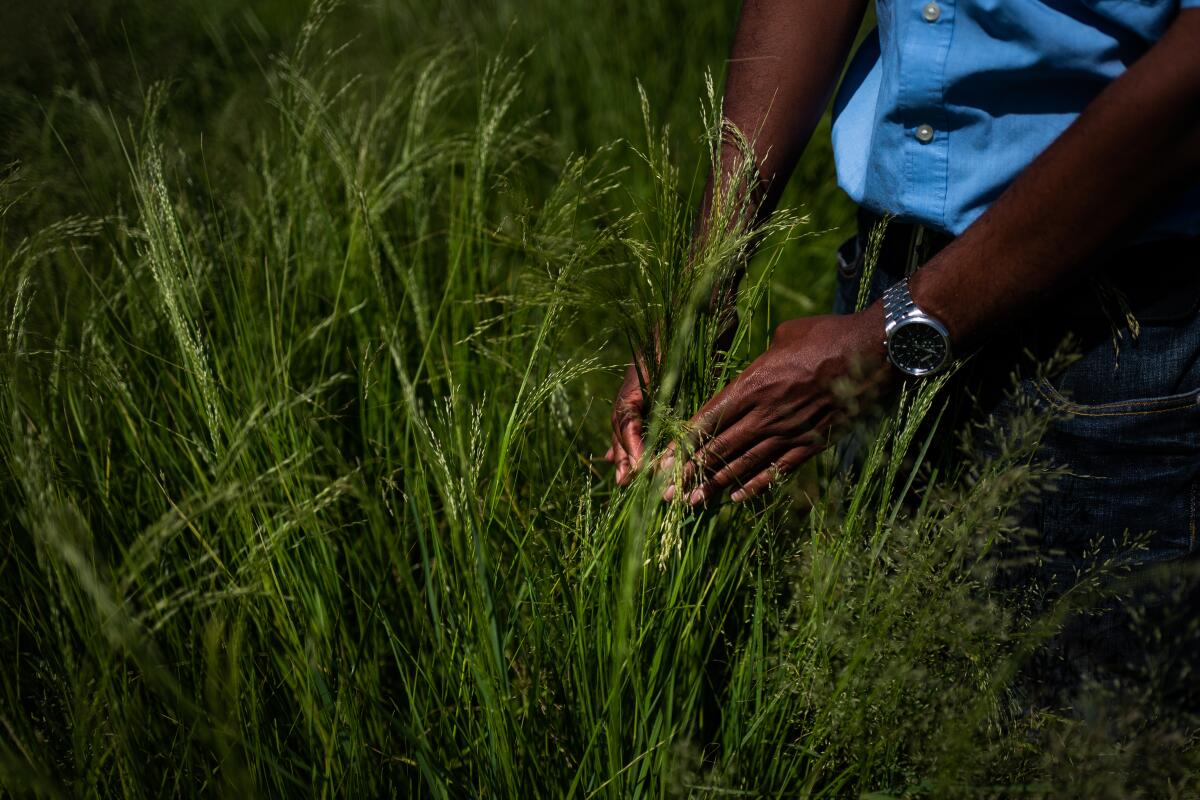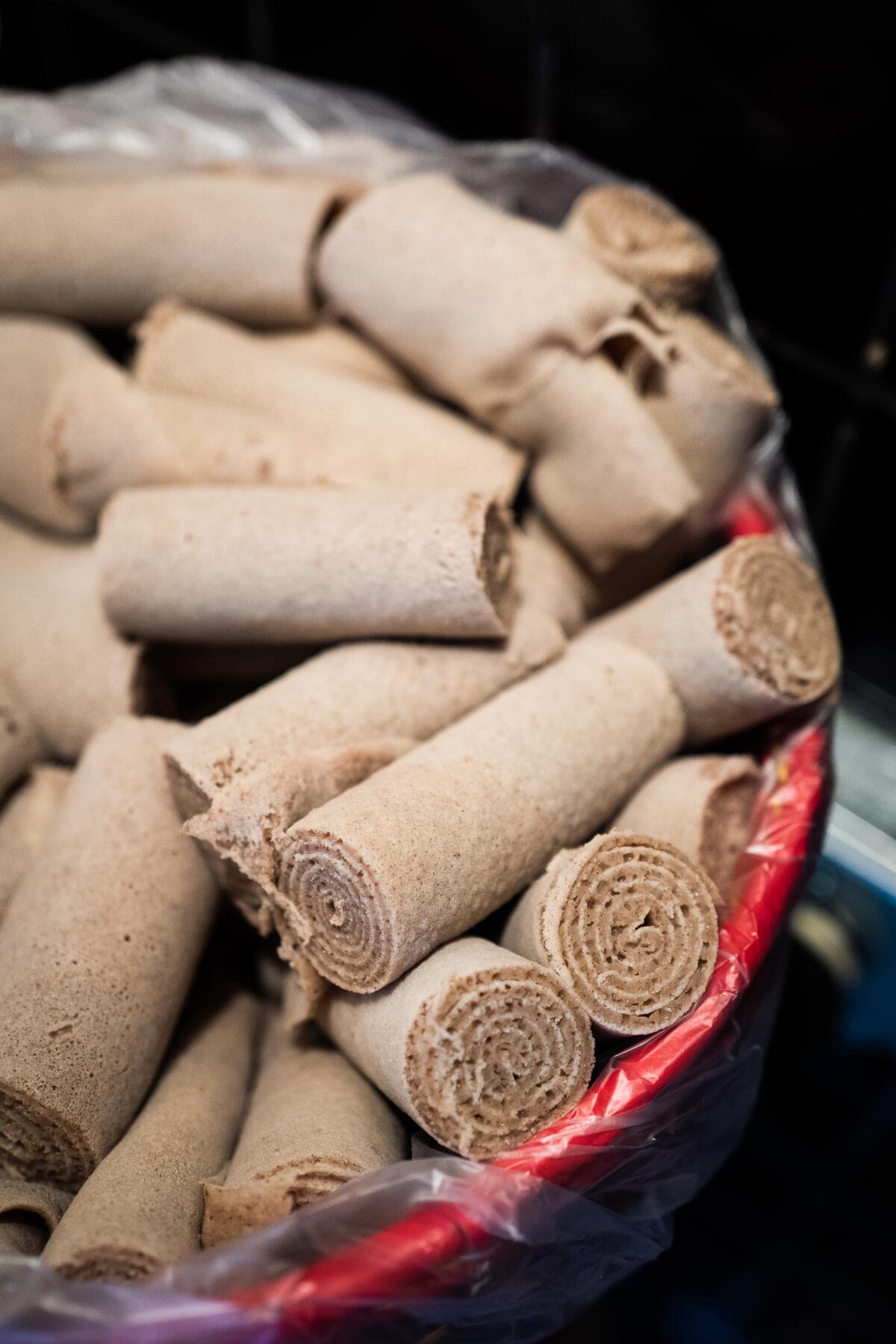Could teff, an ancient African grain, find a foothold in a warming California?

- Share via
Diners press toward the banquet table at downtown Sacramento’s Queen Sheba Ethiopian restaurant, breathing in a scent of home.
The sharp, piquant smell of garlic, onions and ginger pierces the air, mingling with the sweet and fruity smell of radiant green vegetables. Also on the table are a mustard-colored fermented tofu, mashed potatoes, beans and rice.
For the record:
6:54 a.m. Sept. 4, 2019The spelling of Zion Taddese’s name has been corrected.

In the U.S., plant scientists are beginning to study the grain as a serious alternative crop.
The main attraction is far more humble: injera. With a slice of the spongy flatbread in hand, Zion Taddese gently scoops the tofu sauce, tops it with lightly sauteed spinach and gulps it down. “This is really a taste of home,” she says.
Injera tastes earthy and slightly nutty. The gluten-free bread is made in the kitchen Taddese runs from teff — a grain that’s ubiquitous in the Horn of Africa but still virtually unknown in the United States.
Taddese wants to change that, one field at a time, in the Sacramento Valley.
An ivory to brown seed from a type of bunch grass, teff accounts for nearly 70% of the local diet in Ethiopia and neighboring Eritrea. “For us, food is almost incomplete without teff grain,” says Taddese.
Teff is grown and sold mainly as horse feed in the United States, when it is grown at all. But at a time when scientists worry that climate change will decimate the wheat, corn and rice that dominate Western diets, its hardy nature may give teff an edge. Advocates think teff could even be the next superfood; it has three times more iron and almost twice as much fiber as traditional grains, and a more complete suite of amino acids.

“People are going back to quality food now. No matter who you are, rich or poor, quality food is critical now,” Taddese says. She hopes her experience running a farm in her native Ethiopia would be helpful in bringing the crop to farmers in California.
Taddese isn’t alone in her quest. Plant scientists are beginning to study the grass as a serious alternative crop. One of them is Tarrike Berhe, an Ethiopian American who spent 40 years studying rice and other cereal grains. “California is the food basket of the United States, but it also faces serious challenges with water in the future, so we need to diversify the crops that we grow to beat the threat,” he says.
Berhe has courted support from other researchers at UC Davis, who have been looking into teff’s suitability for growth in California for years and are now launching a market study to gauge demand.
“For now, we know the demand could be high. A lot of the restaurants I know of complain to me,” Berhe says.
If it’s not yet familiar to American foodies, teff is known to farmers such as Derek Azevedo, 50. He planted it as a forage for horses starting in 2018.
“We decided to utilize its fast germination,” Azevedo says. “One of the advantages of teff is it has a short growing season, and so if we have the opportunity to plant and harvest one crop and plant another crop within the same growing season, it gives us an opportunity to make good use of our land resources.”
For now, Azevedo only uses the teff grass. “We could take it for grain if we chose to, but we decided to grow it as animal feed,” he says.
Moving niche crops from obscurity into the limelight has never been straightforward.
Consider quinoa, which went from anonymity among American consumers to mass acceptance in a few years. Along the way, the South American superfood was caught up in a tussle over cultural appropriation: The government of Bolivia, which enshrined the right of “food sovereignty” in its constitution, accused American researchers of “biopiracy” for trying to breed it to grow elsewhere.
Demand for the grain has since boomed. Prices nearly tripled between 2006 and 2013, according to the Ag Marketing Resource Center. The United Nations declared 2013 the International Year of Quinoa. Bolivia and its Andean neighbors now export more than 40,000 tons of the grain, both as a tabletop staple and as an ingredient in consumer packaged goods.

Sacramento Valley rice grower Bryce Lundberg leaped into the quinoa craze about seven years ago. But this year he scaled back expansion plans after confronting a glutted market and high production costs. He has abandoned a two-year trial run on about 70 acres in the Imperial Valley, where the higher cost made it uncompetitive with crops such as almonds and tomatoes. Demand for quinoa, he says, may have reached a plateau.
Ethiopia appears to be following Bolivia’s model, so far. It banned export of teff grain for six years to protect local growers who depend on it for subsistence.
That leaves advocates such as Taddese and Berhe with a tough row to hoe. The United States lags behind Australia, Holland, Germany and several other European food powerhouses that have been growing teff for food, anticipating a further surge in global demand.
Like quinoa, teff has low yields per acre, so it will face the same harsh economics in California — competition with higher-value crops that are the state’s niche.
The Queen Sheba restaurant gets its supply from Idaho from the Teff Co. Wayne Carlson, the company founder, lived in Ethiopia in the 1970s as a public health worker. He became a convert to Ethiopian cuisine, learning from local farmers.
On his return to the United States, Carlson and his wife found that the land and weather in their home state was similar to that of the East African country. They tried growing teff seeds in their backyard using techniques for planting alfafa. It worked, and they started a business in 1985, contracting with farmers in Idaho and neighboring Nevada and Oregon to grow teff to supply their mill — a small stone grinder in their basement. Now, they occupy a brewery complex in Nampa, Idaho, with four different mills, supplying packaged teff flour all over the United States.

Their primary consumer base is Ethiopians and Eritreans in the diaspora, many of whom were forced out by political instability in Eritrea and by a brutal famine in Ethiopia in the 1980s.
“A lot of the U.S. population is not necessarily interested in eating injera, so what we are doing is to sell teff in whole-grain form and in flour form and you can integrate that into many foods like porridge,” said Royd Carlson, Wayne’s son, who now manages the business’ chain of farm suppliers.
Berhe is multiplying seeds in a greenhouse in Phoenix, which should be ready in a couple of weeks. “We should be planting them in the Sacramento Valley then,” he said.
The University of California Agriculture and Natural Resources in Davis is conducting a test of teff’s yield, which should be ready in a month. Oli Bachie, the lead researcher, is upbeat.
“What we are looking at is how the seeds will develop under the harsh conditions of California’s desert. If it does withstand, then it’s going to be productive,” he says.
Crops that don’t have a big footprint in the global food economy get little attention from researchers, which makes it tough for farmers to commit to them, Berhe says.
“In terms of productivity, [teff] may not be able to compete with others like rice or wheat,” Berhe said. “But when it comes to nutrition, teff has an advantage. And if farmers can even grow it organically, they’d have tremendous advantage on the market.”
More to Read
Inside the business of entertainment
The Wide Shot brings you news, analysis and insights on everything from streaming wars to production — and what it all means for the future.
You may occasionally receive promotional content from the Los Angeles Times.










